#csm episode 8
Text
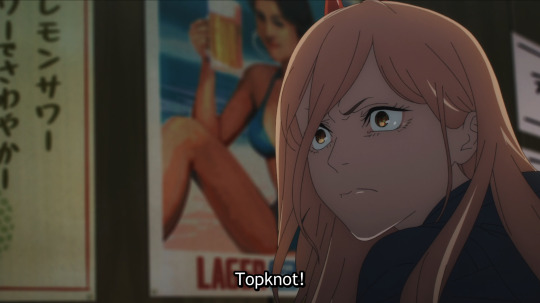

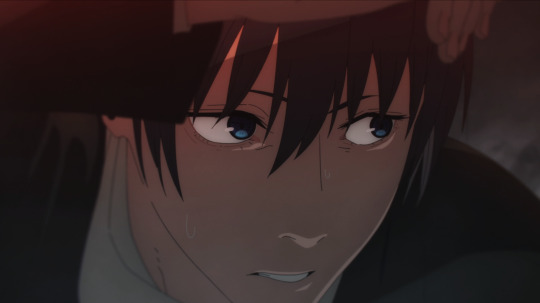


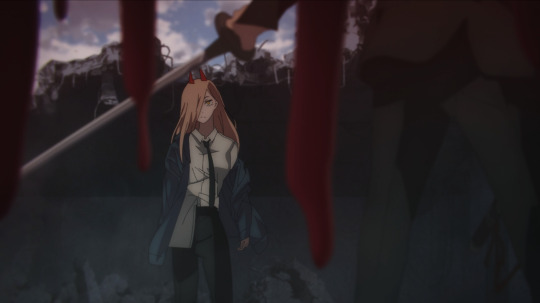
#power and aki teamwork episode 8 *thumbs up emoji*#csm episode 8#chainsaw man#csm#aki hayakawa#kon#power csm
53 notes
·
View notes
Text






parallels in chainsaw man, ED 8: first death
when himeno was alive, the world was full of oranges with blues creeping in at the edges. warm and almost lively, but with the spectre of death surrounding them
when she's gone, the world is overwhelmed by blue with the orange flickering. somber and tragic, heavy with grief, but maybe - the warm light is trying to persist
#chainsaw man#himeno#himeno chainsaw man#aki hayakawa#csm edit#csm spoilers#csm episode 8#csm gif#gifset#my edits#akihime#akimeno#gif /#aki leaves his flowers for himeno then walks towards denji and power. he lost a dear buddy but... he still has a family...#im gonna post more edits later and possibly a more thorough analysis post too#my metas#himeno analysis#my jessays
259 notes
·
View notes
Photo

#like this frame in particular#giving off big Anna energy here#csm episode 8#power (chainsaw man)#power csm#csm power#csm#csm spoilers#csm anime#chainsawman#chainsaw man#chainsaw man spoilers#chainsaw man anime#screencap
80 notes
·
View notes
Text

cmon mappa you did not have to do this
#csm meta#chainsaw man meta#csm analysis#chainsaw man analysis#chainsaw man#csm#aki hayakawa#himeno#akimeno#aki x himeno#himeaki#akihime#im not even a hardcore akimeno truther i think there is worth in platonic readings of their relationship. but also the fucking framing dude#mappa storyboarders went silly for episode 8
167 notes
·
View notes
Text
chainsaw man makes you think its a sick action anime where a horny guy made of chainsaws murders a bunch of guys and gets a sorta fucked up found family along the way, but then you watch it and its actually about a 15 year old boy getting groomed and everybody hates everyone else but theyre mostly busy hating themselves and then everyone dies
#csm spoilers#chainsaw man spoilers#they introduce like 8 characters in one episode and then kill them like two episodes later#half the characters in the intro dont show up until yhe very last episode and they all get like one line apiece#not eyepatch finding out denji is a minor and then STILL TRYING TO SLEEP WITH HIM???#'i didnt take advantage of you last night right? oh good i totally wouldve gone to jail'#HELLO????? DO YOU HEAR YOURSELF????????#ik anime is like that but i still just couldnt stomach the show after that#she died like 5 minutes later tho so it was fine#you lied to me i was promised found family#and i got a bunch of fucked up teens who need therapy but instead get groomed#feel bad show of the year#i get its not supposed to make you feel good by the end#and maybe its really effective for that#but i was upset by the wrong things i think#i didnt care when any of the characters died because they had just been introduced like one episode agu#i didnt even remember any of their names#honestly not a good show#ive never liked mappas stuff#theyre allergic to filler and thats their proboem#they dont take the time to make me care about the characters before they kill them#tl;dr i didnt like it#chainsaw man#csm
16 notes
·
View notes
Text
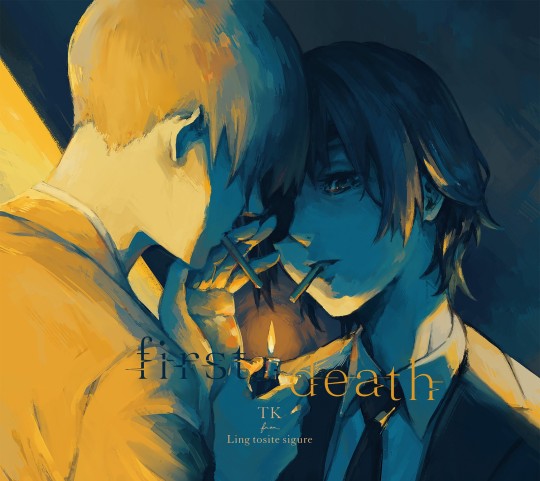
Chainsaw Man ED 8 Album Cover, First Death by Toru Kitajima
#ARE YOU FCKING KIDDING ME RN#csm episode 8 ending was a toru kitajima creation and it was akimeno center?!???#even when i lose I WIN#haven't watched the episode yet but i know it would WRECK me#csm aki#csm himeno#hayakawa aki#akimeno#chainsaw man#csm#toru kitajima#and the cover art omg!!!#csm visual
108 notes
·
View notes
Text
I’d blame @easy-revenge being an enabler, but really I just enable myself.
I want to talk about how the episode 8/“First Death” ED is an absolutely perfect representation of grief.
The very first shot is of two cigarettes. And though smoking is something we the audience have come to associate with Himeno, the presence of two of them suggests that we are meant to view this shot as symbolic of the relationship between Himeno and Aki. From the very outset, the ED makes it clear that the thing we are supposed to take away from this sequence (and, honestly, probably the episode in general) is the strength of their connection. And immediately after this, we get a brief glimpse of a cemetary, crosses marking graves and crows perching on them. Whatever this connection was, it is broken. Himeno is dead.
It’s worth noting that once the guitar kicks in (and thus we have a clearer instrumental that more cleanly represents what we tend to think of as a “song”, instead of the melody-less, monotone, horn-like sound effect backed by drums at the beginning), we are shown more scenes of Aki and Himeno-a memory, a beautifully done shot of both of them lighting cigarettes from the same lighter simultaneously, with all of their history flashing behind them (with special mention to Makima’s eye, adding a creepy and unfortunate shadow over their intimate moments-just like in life), and a scene of an older Aki approaching a younger Himeno in the graveyard where they met, the first of several Grief Shots, all of which never fully show Himeno’s face. Aki is at a physical distance or, in the case of the shot of her walking through a field later on, not present at all. However close the two of them were in life, and however strong or even accurate memories of her can be, she is, ultimately, inaccessible. She’s no longer a living, breathing person, but a specter. She no longer lives, she haunts. The frames shift in and out of focus, both highlighting both the confusing, disorienting nature of personal loss, and creating an effect similar to crying.
We have some slow-moving shots of other characters (including a wonderfully creepy shot of Makima’s eye opening in especially painstaking slow-motion, which...every single animation choice they make with her is a hell of a piece of foreshadowing--oh, and don’t even get me STARTED on the perfect timing of the background shifting to black with a literal explosion of red on the off-beat at the end of the musical phrase *chef’s kiss*), creating a sinister atmosphere, showing us how serious the situation is, reminding us that there are other people in this story to care for, but we quickly shift back to Aki and Himeno, on a bench, at (relative) peace (except not really, because it’s clear that Aki is Thinking About Revenge, but, hey at least they’re not in immediate danger).
Over the course of this ED, we are treated to parallel shots of Himeno in a forest-the first, completely naked, head down, hunched in on herself and obviously deeply sad. The second, in her trademark sleepwear, a sly, slightly flirty smile on her face, still a little folded in on herself, but sitting in a pose of relaxation rather than despair. This comes after, in succession, another Grief Shot of Aki at the graveyard, a butterfly flying through the field Himeno was walking through earlier (now empty-once again, as we are reminded, she is gone), and a screen full of flowers immediately wilting, all suggesting that this is how Aki chooses to remember her-not as a helpless victim of tragedy, but the vibrant, unapologetic person she was in life. There’s a sharp, overlit, dreamy filter over her in this later shot--this is how Aki sees her, someone who deserves to be memorialized, but also someone now far away from him, made distant and different through death.
IN ADDITION (and this is the part where I REALLY start to go feral), the singer’s voice only fully lets loose during the scene of Aki and Himeno fighting together. It’s in a higher register, and the melody doesn’t move at all, staying on the same note. High register chest voice (for those who are not as familiar with singing terms, this, in simplified terms, is basically “not falsetto”) is usually instinctively associated with raw, unbridled emotion. Mainly because it’s farther away from most people’s natural speaking voice, so the approach, vowel modification, and support involved make it harder to sing in healthily, and more difficult to vary in volume, leading to a usually uniformly loud and powerful sound. This sense of raw emotion only comes when showing us just how in tune these two are, just how well they work together, just how easily they are on the same page. The conscious choice to use a vocal technique/register commonly associated with heightened, intense emotion tells us what this connection truly meant and, consequently, conveys the gravity of what has been lost.
And interspersed with this fight, still in the midst of this full, raw vocal display of emotion, there is a shot of their hands connecting, lit in golden-yellow. A casual, automatic moment of physical connection, even in the midst of a dangerous and distinctly non-intimate situation. Yes, it’s devastating that we’ve lost a good, competent team. But even more devastating is that we’ve lost something more than that, something more than even a friendship; we’ve lost a partnership. Even more than coworkers, or even close friends, Aki and Himeno were partners.
This becomes even more overt when the singer shifts into a half-chest-voice, half-falsetto cry (expertly shifting between these two registers, I might add), the furthest jump between notes in the whole song so far present here, and it’s not even on a specific word. Just a vocalized “ah.” Loss cannot be put into words, and sometimes all you can do is sigh or sob or scream. This is the natural culmination of everything we’ve seen, and it is crushing.
The animation shifts in and out of focus again (memories aren’t enough, having a partner for some, not all of your life, isn’t enough), and we have a slow shot of Aki opening his eyes this time. But instead of being ominous or unsettling like in the case of Makima, his eye stays downcast before looking ahead with something bordering on a thousand-yard-stare. This is not horror or a warning, this is grief. And ultimately, despite everything else going on, this is the emotion that wins out. This is the point (at least for now, at this particular moment in the story).
We stay mostly in the graveyard for the rest of the ED, (there’s no use in pretending this is anything other than a mourning song, now), minus a brief moment of Power and Denji looking concerned, while Aki sways slightly, a tad unbalanced (backed by an equally unsteady trill in the guitar line). The stillest we’ve been this whole sequence is a few seconds of Aki simply standing in shadow, head tilted slightly downward, holding flowers, gazing at graves. Grief is hard, it’s paralyzing, and it can be (at least at first) all-consuming. This stillness is broken by a flash of bright-dreamy-filter Himeno (once again, not showing her whole face-just her lips this time), just like how memories and hurt associated with grief can come up violently and unexpectedly. And, now that we’ve fully established this as a Grief Song, when the melody involving the chest-voice-falsetto combo repeats to fill out the musical period and resolve its cadence, we now have words (in fact, we have more syllables than expected) and I don’t think that this particular musical choice matching up with the full shot of Himeno in the forest as fully memorialized by Aki is a coincidence. Himeno is re-realized in some way, and so the ability to put this feeling to words is, too. This memorialization can serve as a brief moment of respite, and so we can return to proper lyrics, instead of a wordless keening.
More of Aki alone in the graveyard, and even as we get a few bars of guitar outro, the somber atmosphere doesn’t let up-Aki’s slow trek through the seemingly endless stretch of graves marked with crosses is bleak and lonely. The last shot set to music is a close-up on his face, looking forlorn and lost at what would be the camera if this were a live-action show.
And then. Cut to silence. A brief shot of flowers (the ever-immortal symbol of grief over death) and a lighter (the ever-immortal symbol of Himeno). Once again, this is not just sadness over a death for the sake of it being a death. This is a loss. This relationship was important, and the melancholy and heartbreak of watching this character die is inextricably tied to the loss of the particular interpersonal connection between Aki and Himeno.
(Also, fun fact: this song is in g minor, which a) has two flats, and b) was a popular key choice of Mozart himself, and is considered to be The Key™ in which he most effectively communicated feelings of despair/tragedy/etc. So. Basically I’m losing my mind in real time.)
There’s also the fact that the beginning and the pre-chorus don’t really have a “key” per se. There’s definitely a background accompaniment, but it’s more general sounds rather than specific pitches. (The bass comes the closest, but it doesn’t quite settle on a pitch.) Grief comes from a lack of something. And just like these parts of the song lack a pitch to center around and use as a home base, sometimes grief feels like you’re missing a part of your life, or even, sometimes, yourself. Maybe it’s not constant, but you feel and notice the absence acutely when it shows up.
And this lack of key/center pitch is eventually contrasted (during the verse and at the end of the pre-chorus) with a constant stream of “g” notes in the guitar line. The home base (or tonic note, if you will) of the scale of the key the overall song is in. That thing you lack, that you miss, that you’re grieving, it’s still there. Everything you had and then lost, you still remember. You still want it back. Grief is persistent and, it doesn’t just go away (even if things would be much easier if it did). It’s going to come up, sometimes in places you don’t expect, and it’s going to hit hard.
(And the fact that grief doesn’t go away carries over into how Himeno is treated in the narrative. There’s the heartbreaking scene in the hospital. There are the flashbacks Aki has before he kills the Ghost Devil. There’s him taking petty revenge on the man responsible for Himeno’s death and all the time he spends taking out, looking at, and eventually smoking the “easy revenge” cigarette. Himeno even features heavily in the ED for the episode after she dies. And I’m not going to spoil things for the anime-only crowd, but there are a few little moments later on in the story, too. Her death isn’t just something that’s forgotten, and her idea of “easy revenge” and making what little joys you can out of life to spite the miserable world around you continues to reverberate through the story, and for Aki specifically. We already see a little of this when he goes berserk on Katana Man despite claiming Himeno wouldn’t want that, and allowing himself to relax a little and even enjoy Power’s and Denji’s company in the episode 12 ending sequence.)
I’ve lost track of the amount of times I’ve watched this. And every time I do, I see something new. The level of care put into this sequence, of using every available tool at the animators’ and musicians’ disposal to so accurately and heart-wrenchingly portray grief is phenomenal. This is an absolutely, breathtakingly stunning ED, and I’m not sure I’ll ever see another one like it.
#himeno#aki hayakawa#chainsaw man#chainsaw man spoilers#csm#csm spoilers#meta#chainsaw man meta#csm meta#akimeno#(I mean. not really. I just choose to read their relationship as romantic because it adds to The Tragedy™ and I love emotional devastation)#akihime#aki x himeno#first death#chainsaw man episode 8#unhinged lady screams about music#behold! a creation!#I got two music degrees and an intense love of anime and I'm not afraid to use EITHER of them
79 notes
·
View notes
Text
I don't care if you weren't sad for Himeno... but watching Aki lose one of his closest friends as she was saving him? That shit was gut wrenching.


92 notes
·
View notes
Text

my contribution to chainsaw man
#this show is. so much#i dont think im gonna get into it into it but like. im on episode 8 i think#chainsaw man#csm#shut up evan
21 notes
·
View notes
Text
RIP Himeno

WHY? 😀
#chainsaw man#csm#aki x himeno#himeno#akimeno#aki#aki hayakawa#csm aki#csm himeno#studio mappa#chainsaw man episode 8#RIP himeno
45 notes
·
View notes
Text

i could talk about how incredible this shot is and how well they adapted this scene. but i’m going to wait for next week when they show my next favorite part of this scene
#episode 8 has pretty much dissolved my anxieties about this adaptation. peak fiction#chainsaw man spoilers#csm spoilers
24 notes
·
View notes
Text
Okay, episode 8 of Chainsaw Man was pretty amazing. Turns out to get to the best action of the series so far, you just need to sit through 8 minutes of a drunk woman trying to fuck a minor.
-In the ramen scene it feels a kinda weird how everyone keeps eating and only Denji seems to pay attention to the dude even after Aki asked everyone if they should leave. Feel like there was some miscommunication in the animation department there of how to depict that scene.
-As pointed out in the last post, Curse's fingerflick could've maybe been done better, but that's a tough thing to adapt, so I don't blame them. And the final kill was pretty cool.
-Kon's appearance (and forceful disappearance) looked amazing and was done super well.
-Ghost's full appearance was my favourite part, that animation was so cool!
-Snake's appearance was... I feel like I'm missing something? They did one thing completely different from the manga and I don't get why? In the manga, Snake "swallows Ghost whole"... and so it seems to swallow everything but the head.

while in the anime... it seems to swallow only the head??? That is such a weird change, I have no idea what the point of it is. It also just goes against the idea of Snake, cause the point is that snakes can swallow their prey whole. It's so confusing.

So yeah, great episode on the whole, I loved it, but that part really just completely baffled me when I took a closer look at it.
10 notes
·
View notes
Text








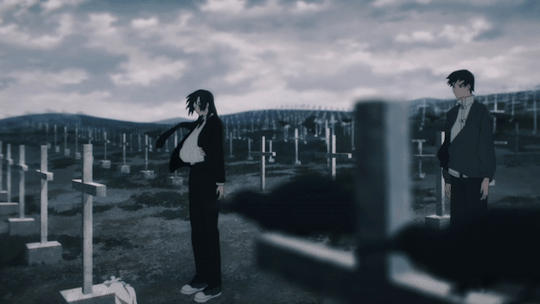








moments between aki and himeno: the shared cigarettes, memories, and griefs
chainsaw man, ED 8
#chainsaw man#csm edit#himeno#himeno chainsaw man#aki hayakawa#makima chainsaw man#makima#akimeno#akihime#csm episode 8#csm spoilers#csm gifset#csm gif#my edits#flashing /#gif /#these were all the moments i could discern anyway and i tried REALLY hard to check frame by frame but some stuff was just inscrutable and#i really hope they weren't anything that i missed LOL..................#but yeah no this fuckin cut was unreal. just so much shit crammed in. they've gone through so much together.....#and then of course........ makima LITERALLY getting in between them.......
95 notes
·
View notes
Photo










#katana man#chainsaw man#csm episode 8#csm anime#csm spoilers#chainsaw man spoilers#chainsaw man anime#chainsawman#long post#screencap#Blood#csm
36 notes
·
View notes
Text
avoiding csm episode 8 like the plague because I already have two fics that I need to finish and based on what I know from the manga timeline, I'm gonna end up writing a 30k aki/himeno fix-it fic if i catch even a minute of that episode
7 notes
·
View notes
Text
Power!!🩸

(please do not edit or repost my art without permission)
#chainsaw man#csm power#csm fanart#pinkee moon art#i was sick for 2 weeks and i'm so glad i can draw again#buuuuut yeah episode 8 DESTROYED me#now i'm really nervous for the rest of the series lol#idk if i can handle how not-permanant these characters are gonna be????#no i have not read the manga lmaooo
9 notes
·
View notes